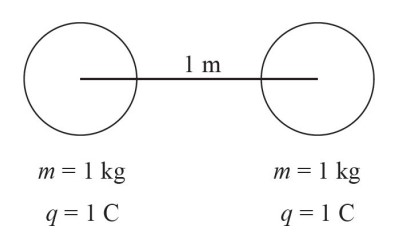Question
A 5×10–6 coulomb electric charge is placed midway between two parallel metal plates connected to a 9–volt battery. If the electric charge experiences a force of 1.5×10–4 newtons, what is the separation of the metal plates?
(A) 6.75 × 10–9 m (B) 2.7 × 10–4 m (C) 3.7 × 10–3 m (D) 0.30 m
▶️Answer/Explanation
Ans:D
Solution: F = Eq and E = V/d giving d = qV/F
Question
A parallel–plate capacitor is connected with wires of negligible resistance to a battery having emf ε until the capacitor is fully charged. The battery is then disconnected from the circuit and the plates of the capacitor are moved to half of their original separation using insulated gloves. Let Vnew be the potential difference across the capacitor plates when the plates are moved together. Let Vold be the potential difference across the capacitor plates when connected to the battery \(\frac{V_{new}}{V_{old}} =\)
(A) ½ (B) 1 (C) 2 (D) 4
▶️Answer/Explanation
Ans:A
Solution: Since the battery is removed, the charge remains constant. If the distance is decreased, the capacitance will increase (C ∝ A/d) and since Q = CV, the potential difference must decrease by the same factor that the distance decreases.
Question

Two identical spheres of mass 1 kg are placed 1 m apart from each other. Each sphere pulls on the other with a gravitational force, \(F_{g}\). If each sphere also holds 1 C of positive charge, then the magnitude of the resulting repulsive electric force is
(A) 1.82 × \(10^{40}F_{g}\)
(B) 1.35 × \(10^{20}F_{g}\)
(C) 7.42 × \(10^{-21}F_{g}\)
(D) 5.50 × \(10^{-41}F_{g}\)
▶️Answer/Explanation
Ans:B
The force of gravity between two objects is given by \(F_{g}=GmM/r^{2}\). This comes out to \((6.67\times10^{-11} )(1)(1)/(1)^{2}=6.67\times10^{-11}\). Electric force is given by \(F_{e}=kqQ/r^{2}\). This comes out to \((8.99\times10^{9})(1)(1)/(1)^{2}=8.99\times10^{9}\). Therefore, in terms of (F_{g}\), \(F_{e}=[(8.99\times10^{9})/(6.67\times10^{-11})]F_{g}=(1.35\times 10^{20})F_{g}\).
Question
Which of the following correctly describes an electron moving from point A to point B in the situation above? Assume the two regions of charge are identical in magnitude and only different in sign.
(A) The electron moves with increasing speed and increasing acceleration and loses potential energy.
(B) The electron moves with increasing speed and constant acceleration and loses potential energy.
(C) The electron moves with increasing speed and increasing acceleration and gains potential energy.
(D) The electron moves with decreasing speed and decreasing acceleration and gains potential energy.
▶️Answer/Explanation
Ans:B
In the diagram, the electron, which has a negative charge, will move from a region of concentrated negative charge to a location of concentrated positive charge. Moving from negative to positive is something a negative charge will do naturally, and natural motion always causes a loss of potential energy. This eliminates (C) and (D).
Acceleration in this case will be constant. At the beginning of its movement, the electron will be primarily pushed away by the negative charges and only gently pulled on by the positive charges. As it travels, the balance of these two forces will trade off, meaning that as the electron approaches point B, it will be primarily pulled by the positive charge and only gently pushed by the negative charge. The total force on the electron, however, will be unchanged throughout, so the acceleration will be constant.
Question
What happens to the electric force between two point charges if the magnitude of both charges are doubled, and the distance between them is halved?
(A) The force is halved.
(B) The force remains the same.
(C) The force is quadrupled.
(D) The force increases by a factor of 16.
▶️Answer/Explanation
Ans:D
Coulomb’s Law is given by

Doubling each charge, and halving the distance between them yields:

